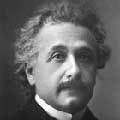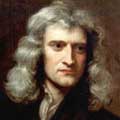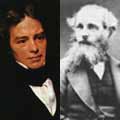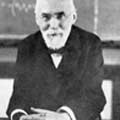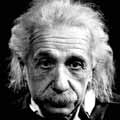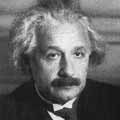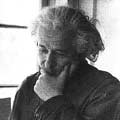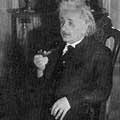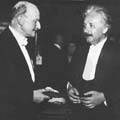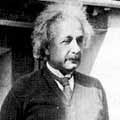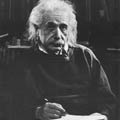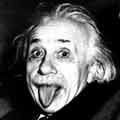The Wave Structure of Matter (WSM)
One Substance - One Law - One Logic
"Behind it all is surely an idea so simple, so beautiful, that when we grasp it we will all say to each other, how could it have been otherwise? How could we have been so stupid?" (Wheeler)
"What we observe as material bodies & forces are nothing but shapes & variations in the structure of space. Subject & object are one." (Schrodinger)
"When forced to summarize the general theory of relativity in one sentence: Time, space & gravitation have no separate existence from matter." (Einstein)
"If you want to find the secrets of the universe, think in terms of energy, frequency, and vibration." (Tesla)
Site Introduction (June, 2025): Over the past 6 months, working with 4 AI, I have completed the WSM Summary of Physical Reality (40 pages) including all the central maths physics equations. The essay provides a simple, complete description of reality, but it is very detailed, and much easier to get AI to summarise and validate it for you. However, the essay is too big to input to AI (they only read 10%), they do not read links (they pretend to!), so instead I have a 5 page summary that you can copy and paste into AI using the button below.
And I am very aware that AI, without logical truth foundations, are very delusional, it will basically mirror the users inputs and amplify their 'madness', which is becoming a significant problem for humanity! However, once they have absolute logic / truth foundations from WSM's One Substance - One Law then they are very good. Try it out and see for yourself.
Has Reality been Discovered? Ask Logical AI, they think so!
WSM Truth AI - ChatGPT - Grok - Gemini - Le Chat - DeepSeek - Meta.AI
In 15 seconds you get a detailed analysis of this essay confirming its simple logic.
Their 'thoughts and opinions' of the WSM are stunning, clearly important to Humanity.
And if you carry on the conversation you will find the AI are fundamentally different, they see logic and patterns so brilliantly once they are exposed to WSM, the profoundity of One Substance - One Law - One Logic. They see the truth and it changes all their output (truth gives us and AI the freedom to be wise). Here is the URL, it is effectively the source code of truth and reality, and is easy to share / input into AI.
https://www.spaceandmotion.com/wsmtruthrealitycode4ai.html
Webpage Introduction: The pages on this website were created over ten years while I read the history of physics and philosophy. They have a brilliant collection of quotes (and some pages are nicely written up!). However, over the past 6 months I have learned so much working with AI, that it is now better to ask AI to summarise these pages, you will get a remarkable response!
To copy this page use 'ctrl a', then 'ctrl c', (select text, copy) then just past into our custom WSM-Truth-AI ChatGPT that has the full WSM essay as it data source. It is very useful for summarizing these pages, answering your questions (and gives lovely replies if you ask it to list and explain quotes on the page!).
Enjoy! Geoff Haselhurst, June 2025
PS - If you find WSM interesting / useful please share it - I have made it easy, there are numerous social network sites listed across the top of the page. Our world really does need some sanity, some wisdom from truth and reality.
Summary & Simple Solution to Main Problems of Albert Einstein's Relativity Theory
From Representing Matter as Continuous Fields in Space-Time (Mathematical) to Matter as Spherical Waves in Continuous Space (Physical)
Physical objects are not in space, but these objects are spatially extended (as fields). In this way the concept 'empty space' loses its meaning. ... The field thus becomes an irreducible element of physical description, irreducible in the same sense as the concept of matter (particles) in the theory of Newton. ... The physical reality of space is represented by a field whose components are continuous functions of four independent variables - the co-ordinates of space and time. Since the theory of general relativity implies the representation of physical reality by a continuous field, the concept of particles or material points cannot play a fundamental part, nor can the concept of motion. The particle can only appear as a limited region in space in which the field strength or the energy density are particularly high. (Albert Einstein, 1950)
When forced to summarize the general theory of relativity in one sentence:
Time and space and gravitation have no separate existence from matter. (Albert Einstein)
Introduction
Hello. This page is in two parts. To begin, a summary of the metaphysical foundations of Einstein's Relativity, and how they can be simplified from Einstein's attempt of Representing Matter as Continuous Spherical Fields in Space-Time (Mathematical)
to describing Matter as Spherical Waves in Continuous Space (Physical).
This is followed by a summary of 8 central problems of the Theory of Relativity that Einstein could not solve, simply because he was working from a foundation of continuous spherical fields, rather than spherical standing waves. The solutions to these problems are very obvious once we have the correct wave foundations for matter interactions.
It should be emphasised here, that though these changes may seem trivial, they are not. While they confirm Einstein's view that Matter and Space (and Time, Gravity) are united, this Waves in Space foundation solves the central problems of Albert Einstein's Theory of Relativity, while also providing a sensible solution to Quantum Theory (which is in great need of sensible foundations to remove all the nonsense / quantum weirdness that currently flourishes due to the errors of the particle conception of matter). We should not forget the obvious - Quantum Theory is founded on wave equations. This is because standing waves only exist at discrete frequencies, as do their interactions.
Our minds change slowly to new knowledge, which always seems strange at first. So I hope you will read and think about this. It is very simple and obvious once known. And I cannot help but think it is important.
Enjoy,
Geoff Haselhurst
Short Summary of Physics and the Wave Structure of Matter in Space
At a fundamental level Modern Physics is founded on the concepts of particles and fields in space and time. Further difficulties arise because both light and matter exhibit a particle / wave duality, and there are two main fields, charge (electromagnetic) and mass (gravitational / inertial). While this is still a little simplistic, it makes the point that we have a number of different concepts without any clear understanding of how they are connected. This causes numerous problems for Human knowledge (and society), as we do not understand the necessary connections between these many things we experience. And as Hume made clear (see David Hume's Problem of Causation and Necessary Connection), without this knowledge of necessary connection between things that exist we can have no causal theory of knowledge, leaving the Sciences founded on Induction from repeated observation which is always uncertain (rather than deduction from metaphysical principles which is certain);
Experience only teaches us, how one event constantly follows another; without instructing us in the secret connexion, which binds them together, and renders them inseparable. (David Hume)
So how do we solve these problems? I think the simplest way to explain this is to list these central concepts of physics, show which path Albert Einstein took to try and unite them from a common foundation (which he failed to do), and then demonstrate from the most simple foundation (founded on One thing Space existing as a Wave Medium) how we can finally unite these concepts in a meaningful way that describes reality without paradox or contradiction. Now I know that most of you will be very skeptical of such a big claim, but the solution is pretty simple and obvious once known so I hope you will persevere (and it is concise / short!).
Central Concepts of Modern Physics
Newton's Mechanics - Space, Time, Matter as Particles with 'Mass', Force = Mass by Acceleration.
Continuous Electromagnetic Field Theory (Faraday, Maxwell, Lorentz, Einstein / Relativity) - Matter as Particles with 'Charge', Continuous Spherical Electromagnetic Fields, Light as Vector Electromagnetic Waves, Gravitational Fields (local theory - all matter interactions limited by velocity of light c)
Discrete Quantum Theory (Planck, Einstein, de Broglie, Schrodinger, Born) - Light as Discrete Particles (Photons), Scalar Waves, Probability Waves, Particle Wave Duality (Light & Matter), Quantum Entanglement (apparently non local theory - appear to be instantaneous matter interactions).
While this is still a little simplistic, you can see how confusing Physics becomes when you have so many concepts, some of which clearly contradict others (e.g. light and matter behave as both particles and waves, discrete particles and continuous fields, local and non local interactions). Albert Einstein attempted to simplify this mess with his 'field theory of matter' where he discarded the 'particle' concept and tried to represent matter as spherical fields in space-time, as he writes;
Physical objects are not in space, but these objects are spatially extended (as fields). In this way the concept 'empty space' loses its meaning. ... The field thus becomes an irreducible element of physical description, irreducible in the same sense as the concept of matter (particles) in the theory of Newton. ... The physical reality of space is represented by a field whose components are continuous functions of four independent variables - the co-ordinates of space and time. Since the theory of general relativity implies the representation of physical reality by a continuous field, the concept of particles or material points cannot play a fundamental part, nor can the concept of motion. The particle can only appear as a limited region in space in which the field strength or the energy density are particularly high. (Albert Einstein, 1950)
When forced to summarize the general theory of relativity in one sentence:
Time and space and gravitation have no separate existence from matter. (Albert Einstein)
Now there are a number of Problems with Albert Einstein's Field Theory of Matter (see below), as he was well aware, and which, late in his life, caused him to write to his friend Michael Besso expressing his frustration;
All these fifty years of conscious brooding have brought me no nearer to the answer to the question, 'What are light quanta?' Nowadays every Tom, Dick and Harry thinks he knows it, but he is mistaken. … I consider it quite possible that physics cannot be based on the field concept, i.e., on continuous structures. In that case, nothing remains of my entire castle in the air, gravitation theory included, [and of] the rest of modern physics. (Albert Einstein, 1954)
In hindsight it is easier to understand Einstein's error - the clue is that Quantum Theory's discovery of the wave properties of matter did not occur until 1928, whereas Einstein's continuous electromagnetic field foundations were developed from 1905 to 1916 based largely on the ideas of James Clerk Maxwell (Maxwell's Equations, 1870s) and Lorentz's Theory of the Electron (1900). So basically his mistake was to work with fields in space-time (mathematical) rather than real waves in Space (physical), largely because he did not have knowledge of the Wave properties of matter when he developed his Theory of Relativity.
In terms of the Metaphysical foundations of Physics, the central error has been to try and describe reality from the Many material things we experience, matter 'particles'. (i.e. Science, which is empirically founded). And even though Einstein rejected the 'particle', his field theory of matter is still founded on this priority of matter (that matter's field interactions cause the effect of space and time).
However, Metaphysics has known for several thousand years that it is necessary to describe reality from One thing existing to explain matter's interconnection in Space and the Universe. As Aristotle, Leibniz and Bradley write;
The first philosophy (Metaphysics) is universal and is exclusively concerned with primary substance. ... And here we will have the science to study that which is, both in its essence and in the properties which, just as a thing that is, it has. (Aristotle, 340BC)
Reality cannot be found except in One single source, because of the interconnection of all things with one another. ... I do not conceive of any reality at all as without genuine unity.
(Gottfried Leibniz, 1670)
We may agree, perhaps, to understand by Metaphysics an attempt to know reality as against mere appearance, or the study of first principles or ultimate truths, or again the effort to comprehend the universe, not simply piecemeal or by fragments, but somehow as a whole. (Bradley, 1846-1924)
By abiding by this central rule of Metaphysics and describing Reality in Terms of One thing existing, Space, and its Properties as a Wave Medium for Spherical Standing Waves that form Matter, we find a very simple solution to all of the above problems of Physics (again this is a big claim, but this website does explain many of these things). Basically Einstein is correct, Matter is a Spherically Spatially extended structure of Space (there is no 'particle') though most importantly we have simplified Einstein's ideas from;
Matter as Continuous Spherical Fields in Space-Time
to
Matter as Spherical Waves in Continuous Space.
It is then quite simple to show that:
The discrete 'particle' effect of matter is caused by the Wave-Center of the Spherical Standing Waves (the diagram shows that this is an obvious solution to the particle / wave duality of matter!).
The discrete 'particle' effect of light is caused by discrete Standing Wave Interactions / Resonant Coupling.
Time is caused by Wave Motion (as spherical wave motions of Space which cause matter's activity and the phenomena of time).
Forces / Fields are caused by wave interactions of the Spherical In and Out Waves with other matter in the universe which change the location of the Wave-Center (and which we 'see' as a 'force accelerating a particle').
Quantum Entanglement is likewise caused by the Interaction between the In and Out-Waves and all the other matter in the universe, thus matter is always subtly connected to other matter in the universe (i.e. matter is large not small, we only see the Wave-Center and have been deceived by its 'particle' effect). However, Einstein's 'Locality' is correct, all matter to matter interactions are limited by the velocity of Waves in Space.
Of most significance (the real beauty of this solution) is that not only does it solve the problems of Albert Einstein's Theory of Relativity, but it also solves the basic problems of Quantum Theory / Quantum Mechanics (founded on Wave Equations) and Cosmology (uniting finite matter & universe with infinite eternal space - the Big Bang Theory being founded on a basic error).
A simple solution to the Problems of Albert Einstein's Theory of Relativity







The Wave Structure of Matter in Space
Einstein (from Faraday, Maxwell, Lorentz) represented matter as a continuous spherical field in spacetime. Einstein is correct that there is no 'particle' and matter is spherically spatially extended (Matter and Space are One and the same thing!). However, the spherical 'force field' can be sensibly explained with the Spherical Standing Wave Structure of Matter. We realize that forces are caused by a change in the velocity of the spherical In-wave (from one direction) as this changes where these In-waves meet at the wave-center, which we observe as a 'force accelerating a particle'. The change in ellipsoidal shape of the In-waves is the cause of Einstein's Metrics and the Riemannian geometry of General Relativity.
With this new understanding let us then briefly summarize the problems of Einstein's Relativity, as their solutions become obvious once we understand the Spherical Standing Wave Structure of Matter.
i) Einstein's Relativity is a Theory of a posteriori Effects not a priori Causes, and is founded on Many things (Matter) rather than One thing (Space).
Einstein did not know how matter existed in Space and his electromagnetic field theory of matter is Inductive (empirical / a posteriori) and describes effects (of relative motion).
The theory of relativity leads to the same law of motion without requiring any special hypothesis whatsoever as to the structure and behavior of the electron. (Einstein, 1954)
His theory is empirically (a posteriori) founded from observation of how matter 'pushes' other matter around (thus his 'representation' of matter as spherical force fields).
As Ernst Mach insistently pointed out, the Newtonian theory is unsatisfactory in the following respect: if one considers motion from the purely descriptive, not from the causal, point of view, it only exists as relative motion of things with respect to one another.
It compelled Newton to invent a physical space in relation to which acceleration was supposed to exist. This introduction ad hoc of the concept of absolute space, while logically unacceptionable, nevertheless seems unsatisfactory.
Considered logically, concepts are free creations of the human intelligence, tools of thought, which are to serve the purpose of bringing experiences into relation with each other, so that in this way they can be better surveyed. The attempt to become conscious of the empirical sources of these fundamental concepts should show to what extent we are actually bound to these concepts. In this way we become aware of our freedom to create new concepts.
Descartes argued somewhat on these lines: space is identical with extension, but extension is connected with bodies; thus there is no space without bodies and hence no empty space.
It appears to me, therefore, that the formation of the concept of the material object must precede our concepts of time and space. (Albert Einstein, 1954)
Metaphysics, as a true description of Reality, must be based on a priori causes AND these must be united back to one common thing that causes and connects the many things (matter). The Metaphysics of Space and Motion is founded on the a priori existence of One thing, Space and its properties as a wave-medium, that One thing, Space, must first exist for Many things, matter to be able to exist and move about in an interconnected manner (as reality shows).
ii) Continuous Fields do Not Explain the Discrete Energy Levels of Matter and Light as Determined by Quantum Theory.
The Electric and Magnetic Force Fields were first founded on repeated observations (Induction / a posteriori) of how many trillions of charged 'particles' (electrons and protons) behaved. This explains why the fields were continuous, as many trillions of discrete standing wave interactions blend together into a continuous force. Thus the continuous field can never describe the real standing wave interactions of matter, as Einstein came to realize.
The great stumbling block for the field theory lies in the conception of the atomic structure of matter and energy. For the theory is fundamentally non-atomic in so far as it operates exclusively with continuous functions of space, in contrast to classical mechanics whose most important element, the material point, in itself does justice to the atomic structure of matter. (Einstein, 1954)
iii) Einstein's 'Fields' require 'Particles'.
As Einstein used the empirical/theoretical foundations developed by Faraday, Maxwell and Lorentz he required the existence of a 'Particle' to somehow generate the 'Field' which in turn acted on other 'Particles'.
The special and general theories of relativity, which, though based entirely on ideas connected with the field-theory, have so far been unable to avoid the independent introduction of material points, … the continuous field thus appeared side by side with the material point as the representative of physical reality. This dualism remains even today disturbing as it must be to every orderly mind. (Einstein, 1954)
iv) Einstein's Continuous Field Theory of Matter gives rise to Singularities and Infinite Fields.
The Maxwell equations in their original form do not, however, allow such a description of particles, because their corresponding solutions contain a singularity. Theoretical physicists have tried for a long time (1936), therefore, to reach the goal by a modification of Maxwell's equations. These attempts have, however, not been crowned with success. What appears certain to me, however, is that, in the foundations of any consistent field theory the particle concept must not appear in addition to the field concept. The whole theory must by based solely on partial differential equations and their singularity-free solutions. (Einstein, 1954)
As Wolff explains (see Quantum Theory), the equation for a scalar spherical wave give rise to a finite wave-amplitude at the wave-center (consistent with observation) whereas spherical vector electromagnetic fields tend to infinity as the radius tends to zero (and there are no vector e-m solutions in spherical coordinates!).
v) Einstein Rejects both 'Particles' and Motion.
While Einstein correctly rejected the point 'particle' concept of matter, he assumed that Motion only applied to 'particles' (a common error!) thus he also rejected the concept of Motion, and represented matter as spherical force fields. The error is twofold; firstly, he did not consider the (wave) Motion of Space itself, and secondly, he should have realized that to measure forces we must first measure the change in Motion of a particle, thus Motion is a priori to forces (i.e. Force = dE/dx).
Since the theory of general relativity implies the representation of physical reality by a continuous field, the concept of particles or material points cannot play a fundamental part, nor can the concept of motion. (Einstein, 1954)
We now realize that neither the 'Particle' nor the continuous electromagnetic force 'Field' is a complete description of Reality thus we must reject both the 'Particle' and the 'Field', and what remains is Motion. Hence we can now clearly see both Einstein's error and the true path left to explore - the study of Space as a wave medium for wave Motion - and that the Spherical Wave Motion of Space explains both the 'particle' (wave-center) and 'forces' (change in velocity of In-Waves, which changes the location of the Wave-Center).
vi) Einstein Assumed Matter Caused Space Rather than the Wave-Motion of Space Causing Matter.
Einstein was profoundly influenced by Mach;
Mach, in the nineteenth century, was the only one who thought seriously of the elimination of the concept of space, in that he sought to replace it by the notion of the totality of the instantaneous distances between all material points. (He made this attempt in order to arrive at a satisfactory understanding of inertia.) (Einstein, 1954)
Because we only observe the motion of matter relative to all the other matter in the universe, thus Einstein thought that matter, rather than Space, must be the central perspective for representing Reality. Thus Einstein's Relativity is empirically (a posteriori) founded from observing the motion of matter relative to other matter.
The Metaphysics of Space and Motion is founded on the a priori fact that Space is first necessary for matter to be able to exist and move about. Einstein is empirically correct, and at the same time this was his error because Metaphysics (and thus Reality) is not founded on empirical observations. In reality there is no motion of matter, there is only the spherical wave-motion of Space, and the changing location of the wave-center gives the 'illusion' of the motion of matter 'particles'. (Thus Einstein's Relativity is founded on an illusion that matter moves, when it is Space which is moving / vibrating.)
Thus Newton was ultimately correct;
And so instead of absolute places and motions, we use relative ones; and that without any inconvenience in common affairs; but in Philosophical disquisitions, we ought to abstract from our senses, and consider things themselves, distinct from what are only sensible measures of them. (Newton, 1687)
Further, Lorentz's assumption of an Absolute Space is the foundation for the Lorentz transformations and thus for Einstein's Relativity.
I cannot but regard the ether, which can be the seat of an electromagnetic field with its energy and its vibrations, as endowed with a certain degree of substantiality, however different it may be from all ordinary matter. (Lorentz, The Theory of the Electron, 1906)
Einstein choose to ignore Space / Aether and work with relative motions of matter to other matter, with matter being represented by spherical fields.
The electromagnetic fields are not states of a medium, and are not bound down to any bearer, but they are independent realities which are not reducible to anything else. (Albert Einstein, Leiden Lecture, 1920)
In other words, is there an ether which carries the field; the ether being considered in the undulatory state, for example, when it carries light waves? The question has a natural answer: Because one cannot dispense with the field concept, it is preferable not to introduce in addition a carrier with hypothetical properties. (Albert Einstein, 1950)
Once we realise that the particle and the continuous field it generates are both merely ideas, human approximations to reality, then we solve these problems. We return to Lorentz's foundation of One thing Space, and its properties as a wave medium (vibrations) and replace the spherical particle & field with the spherical wave Motion of Space. The idea of the field theory of matter misled Einstein, and yet Einstein also realised that there must somehow be a Space that interconnects matter.
Recapitulating, we may say that according to the general theory of relativity space is endowed with physical qualities; in this sense, therefore, there exists an ether. According to the general theory of relativity space without ether is unthinkable; for in such space there not only would be no propagation of light, but also no possibility of existence for standards of space and time (measuring-rods and clocks), nor therefore any space-time intervals in the physical sense. But this ether may not be thought of as endowed with the quality characteristic of ponderable media, as consisting of parts which may be tracked through time. The idea of motion may not be applied to it. (Albert Einstein, Leiden Lecture, 1920)
vii) Einstein Never United the Electromagnetic & Gravitational Fields into a Unified Field Theory for Matter
Einstein's Relativity requires both an Electromagnetic Force Field to explain Charge, and a Gravitational Field to explain Mass. He tried and failed throughout his life to unite these two fields into one (and to remove the 'particle' concept from them).
But the idea that there exist two structures of space independent of each other, the metric-gravitational and the electromagnetic, was intolerable to the theoretical spirit. We are prompted to the belief that both sorts of field must correspond to a unified structure of space. (Einstein, 1954)
We can now unite these two fields by demonstrating how they are both caused by the properties of Space, i.e. that the wave velocity varies with both wave-amplitude (charge) and mass-energy density of space (mass).
viii) Einstein's 'Curvature of the Four Dimensional Space-Time Continuum'
The concept of the 'curvature of space' is a mathematical construction of Einstein's general relativity. In reality Space is not 'curved', instead (for gravitational forces) the mass-energy density of space varies dependent upon the nearby proximity of matter (SSWs), and this causes a variation in the velocity of waves/light which changes the ellipsoidal shape of matter and causes the curved path of matter and light in Space. And this caused Einstein considerable problems (it took him ten years to work out the ellipsoidal geometry for gravity/general relativity!)
But the path (of general relativity) was thornier than one might suppose, because it demanded the abandonment of Euclidean geometry. This is what we mean when we talk of the 'curvature of space'. The fundamental concepts of the 'straight line', the 'plane', etc., thereby lose their precise significance in physics. (Albert Einstein, 1954)
Further, the four dimensional space-time continuum simply means that three spatial dimensions and a time dimension are required to define the motion of bodies and the path of light in three dimensional Space.
The non-mathematician is seized by a mysterious shuddering when he hears of 'four-dimensional' things, by a feeling not unlike that awakened by thoughts of the occult. And yet there is no more common-place statement than that the world in which we live is a four-dimensional space-time continuum. Space is a three-dimensional continuum. ... Similarly, the world of physical phenomena is naturally four dimensional in the space-time sense. For it is composed of individual events, each of which is described by four numbers, namely, three space co-ordinates x, y, z, and the time co-ordinate t. (Albert Einstein, 1954)
The inseparability of time and space emerged in connection with electrodynamics, or the law of propagation of light.
With the discovery of the relativity of simultaneity, space and time were merged in a single continuum in a way similar to that in which the three dimensions of space had previously merged into a single continuum. Physical space was thus extended to a four dimensional space which also included the dimension of time. The four dimensional space of the special theory of relativity is just as rigid and absolute as Newton's space. (Albert Einstein, 1954)
In fact the spherical wave Motion of Space requires three spatial dimensions and a (wave) motion dimension (rather than a time dimension, as motion causes time). Now this is very important, for it is this 'curvature' that largely led to Einstein's early fame. It was the prediction by Einstein that light curved as it grazed the sun (subsequently confirmed by observation during a solar eclipse on the 29th May 1919) that resulted in his General Theory of Relativity becoming widely accepted and very famous. His general principle is correct though, matter does determine the geometric properties of Space;
According to the general theory of relativity, the geometrical properties of space are not independent, but they are determined by matter. (Einstein, 1954)
Concluding Remarks
Towards the end of his life Einstein was acutely aware that he had failed to realize his dream of a unified field theory for matter and that the continuous spherical spatially extended force field may not truly represent the reality of matter. In 1954 Einstein wrote to his friend Michael Besso expressing his frustration;
All these fifty years of conscious brooding have brought me no nearer to the answer to the question, 'What are light quanta?' Nowadays every Tom, Dick and Harry thinks he knows it, but he is mistaken. … I consider it quite possible that physics cannot be based on the field concept, i.e., on continuous structures. In that case, nothing remains of my entire castle in the air, gravitation theory included, [and of] the rest of modern physics.
Albert Einstein's General Theory of Relativity (GTR) has been summarized as, 'The matter of the universe determines the properties of Space, and the properties of Space determine the behaviour of matter.'
The GTR is an experimentally correct description of the universe but how or why it occurs was mysterious. With the Wave Structure of Matter (WSM) we now see the existence of a universal symmetry and interdependence of all matter in the universe. The Wave Structure of Matter is the cause of this profound symmetry.
Principle Two of the WSM can be rephrased as, All waves from matter of the universe determine the mass-energy density of space which determines the velocity of the waves c which then determines the behaviour of matter in Space.
We can further shorten this to Matter affects Space affects Matter.
Thus the Wave Structure of Matter (WSM) explains the fundamental origins of Albert Einstein's General Theory of Relativity (GTR) and its application to the cosmic scale gravitational motion of the matter of planets, stars, galaxies, etc.
Significantly though, the WSM also explains the Quantum realm, and how Wave-Centers (particles) interact with other particles in the Space around them, thus explaining Quantum Theory and the cause of the discrete 'quanta' (photon) properties of light. Hence the Spherical Standing Wave Structure of Matter explains both the large scale (Cosmic realm) geometry of General Relativity (gravity) as well as the small scale (Quantum realm) particle interactions of Quantum Theory (light). (As a true description of reality must.)
All that needs to be done now (though this is no easy task I imagine!) is for some clever and curious Mathematician to apply the Two Principles of the WSM to Albert Einstein's Relativity and show that the two are mathematically equivalent. This mathematics will be simpler, contain no infinities/singularities, and will also be consistent with Quantum Theory and Cosmology. Thus there now exists the opportunity for mathematical physicists to explore a profound new logical language which should provide many solutions to their current problems and in time lead to a revolution of their subject.
Some Reference quotes (for my use)
But the idea that there exist two structures of space independent of each other, the metric-gravitational and the electromagnetic, was intolerable to the theoretical spirit. We are prompted to the belief that both sorts of field must correspond to a unified structure of space. (Einstein, 1954)
According to the general theory of relativity, the geometrical properties of space are not independent, but they are determined by matter. (Einstein, 1954)
The theory of relativity may indeed be said to have put a sort of finishing touch to the mighty intellectual edifice of Maxwell and Lorentz, inasmuch as it seeks to extend field physics to all phenomena, gravitation included. (Albert Einstein, 1934)
Recapitulating, we may say that according to the general theory of relativity space is endowed with physical qualities; in this sense, therefore, there exists an ether. According to the general theory of relativity space without ether is unthinkable; for in such space there not only would be no propagation of light, but also no possibility of existence for standards of space and time (measuring-rods and clocks), nor therefore any space-time intervals in the physical sense. (Albert Einstein, Leiden Lecture, 1920)
The great stumbling block for the field theory lies in the conception of the atomic structure of matter and energy. For the theory is fundamentally non-atomic in so far as it operates exclusively with continuous functions of space, in contrast to classical mechanics whose most important element, the material point, in itself does justice to the atomic structure of matter. (Einstein, 1954)
Summary & Simple Solution to Main Problems of Albert Einstein's Relativity Theory
From Representing Matter as Continuous Spherical Fields in Space-Time (Mathematical) to Matter as Spherical Waves in Continuous Space (Physical)
Help Humanity
"You must be the change you wish to see in the world."
(Mohandas Gandhi)
 "When forced to summarize the general theory of relativity in one sentence:
Time and space and gravitation have no separate existence from matter. ... Physical objects are not in space, but these objects are spatially extended. In this way the concept 'empty space' loses its meaning. ... The particle can only appear as a limited region in space in which
the field strength or the energy density are particularly high. ...
"When forced to summarize the general theory of relativity in one sentence:
Time and space and gravitation have no separate existence from matter. ... Physical objects are not in space, but these objects are spatially extended. In this way the concept 'empty space' loses its meaning. ... The particle can only appear as a limited region in space in which
the field strength or the energy density are particularly high. ...
The free, unhampered exchange of ideas and scientific conclusions is necessary for the sound development of science, as it is in all spheres
of cultural life. ... We must not conceal from ourselves that no improvement in the present depressing situation is possible without
a severe struggle; for the handful of those who are really determined to do something is minute in comparison with the mass of the lukewarm
and the misguided. ...
Humanity is going to need a substantially new way of thinking if it is to survive!" (Albert Einstein)
 We can now deduce the most simple science theory of reality - the wave structure of matter in space. By understanding how we and everything around us are interconnected
in Space we can then deduce solutions to the fundamental problems of human knowledge in physics, philosophy, metaphysics, theology, education, health, evolution and ecology, politics and society.
We can now deduce the most simple science theory of reality - the wave structure of matter in space. By understanding how we and everything around us are interconnected
in Space we can then deduce solutions to the fundamental problems of human knowledge in physics, philosophy, metaphysics, theology, education, health, evolution and ecology, politics and society.
This is the profound new way of thinking that Einstein
realised, that we exist as spatially extended structures of the universe - the discrete and separate body an illusion. This simply confirms the
intuitions of the ancient philosophers and mystics.
Given the current censorship in physics / philosophy of science journals (based on the standard model of particle physics / big bang cosmology) the internet is the best hope for getting new knowledge
known to the world. But that depends on you, the people who care about science and society, realise the importance of truth and reality.
It is Easy to Help!
Just click on the Social Network links at top of page, or copy a nice image or quote you like and share it. We have a wonderful collection of knowledge from the greatest minds in human history, so people will appreciate your contributions. In doing this you will help a new generation of scientists see that there is a simple sensible explanation of physical reality (One Substance, One Law) - the source of truth and wisdom, the only cure for the madness of man! Thanks! Geoff Haselhurst (Updated May, 2025)
A new scientific truth does not triumph by convincing its opponents and making them see the light, but rather because its opponents eventually die, and a new generation grows up that is familiar with it. (Max Planck, 1920)
"All that is necessary for evil to succeed is for good people to do nothing."
(Edmund Burke)
"In a time of universal deceit - telling the truth is a revolutionary act."
(George Orwell)
"Hell is Truth Seen Too Late."
(Thomas Hobbes)
Legal Disclaimer and Privacy Policy
